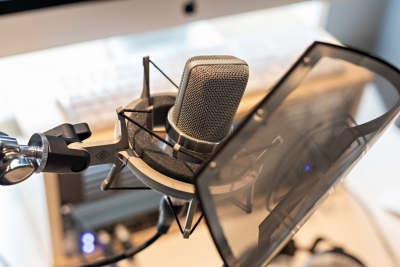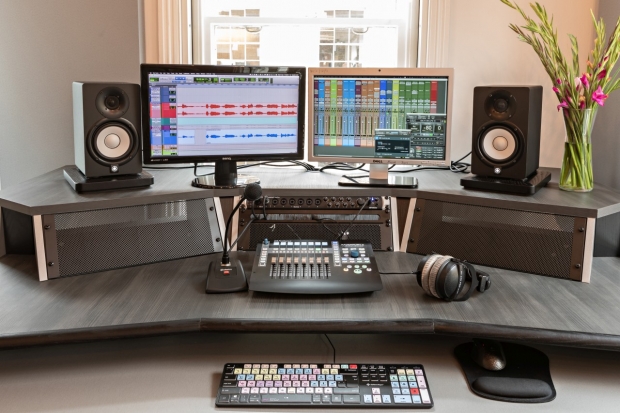The Voiceover Gallery founding director Marylou Thistleton-Smith discusses her company’s practice of not providing voice acting talent images on its website, despite resistance both internally and from the animation community, explaining how visual anonymity in casting can challenge and reduce unconscious bias, promoting talent over appearance.
 NEWSFLASH – The Voiceover Gallery doesn’t have photos of any of their talent on its website and hasn’t for the 20 years since the company was founded in 2004.
NEWSFLASH – The Voiceover Gallery doesn’t have photos of any of their talent on its website and hasn’t for the 20 years since the company was founded in 2004.
This may not sound like news, but there has been resistance both internally and externally to this stance that I took from day one, as the founding director, and I have never wavered from that stance.
To me, the reason is obvious, especially for animated projects, and the pandemic only strengthened my resolve.
When casting for the UK version of Thomas & Friends, right in the middle of COVID, we couldn’t meet any of the children playing the characters in person, which meant all casting was done over the phone. In fact, we didn’t meet the cast until halfway through production. They were selected based entirely on talent and sound – as should be the case with all voice casting.
Think about it: what do you think of when you hear someone’s voice without seeing how they look? We certainly make assumptions about age, gender, and perhaps also their background or ethnicity. It is likely we make a huge number of micro decisions about the individual just from the sound of their voice and build a picture on which we then base any relationship we have with them moving forward.
How often have you spoken to someone on the phone for months, just like we did and, then finally met them? It’s always a bit of a shock, right? No one EVER looks like how they sound.
Those presumptions you made when you first heard them all those months ago will not be universal and everyone will have their own idea of what someone looks like. This will be based on life experience, other people you know, the sensitivity of your hearing, and so on. However, 99.9% of the time, they won’t match your expectations of how they look.
This is precisely the basis on which voices are cast for voice over projects – what picture will our audience create from this voice and is it appropriate to promote our product? Will it entice and engage the right people?
It really is that simple.
 For example, for a financial institution promoting its 20-year history, you wouldn’t use a voice that sounded 25 years old because what would someone that age know about investing my money? Equally, Apple will choose someone younger and DFS (a UK sofa retailer) tends to use regional accents to appeal to a wider audience.
For example, for a financial institution promoting its 20-year history, you wouldn’t use a voice that sounded 25 years old because what would someone that age know about investing my money? Equally, Apple will choose someone younger and DFS (a UK sofa retailer) tends to use regional accents to appeal to a wider audience.
Casting decisions are made based on wide stereotypes that appeal to the appropriate demographic purely in terms of how that voice might be perceived as a person. British audiences are all familiar with the enticing female voice who voiced the first sensual M&S food ads. How would those have sounded with a less refined voice? A male voice?
So, what happens if you know what the person looks like before you hear their voice; is the opposite now true and you start deciding how they sound based on how they look? Would you press play on the demo of a man who looks 40 if you wanted a 25-year-old sound?
If you were after a sexy female voice, would you listen to the demo of a woman you didn’t find sexy in their photo? Does it follow that someone who looks sexy, also sounds sexy? Over the years, we have worked with talent that has “a face for radio,” with voices like velvet. Most of us have an unconscious bias that would never have selected them to be the sultry, smooth voice that was required. Equally, not all our attractive people are the best talents. We have a 50+-year-old that can play a 16-year-old more convincingly than some 16-year-olds.
It is fundamentally true that we prejudge everyone – we can’t help it. Which is precisely why you won’t find photos of our voices on The Voiceover Gallery website. We are selling voices, not faces, and while the old adage says, “people buy with their eyes,” we don’t think some of our voices would ever get a job if that were the case! It’s all about the image that voice creates and how well it fits your brief. It’s all about illusion and letting your audience imagine what the person talking looks like for them, because once you put a face to the voice, it may shatter that illusion.
This concept is perfectly encapsulated in the reality TV singing contest, The Voice, where contestants enter a “Blind Auditions” round, where the judges can’t see what they look like. If the judge likes what the contestant sounds like once they’ve started singing, they can then turn their chair around to see them. A great singing voice doesn’t always come out of a buffed and coiffed body, as Susan Boyle very aptly proved.
This theory couldn’t be truer than in animation, with many of your favorite characters voiced by actors who completely defy expectation. Who remembers the first time they found out Bart Simpson was in fact voiced by a woman (Nancy Cartwright) – and if you had known that information from the beginning, would the illusion have been the same? The same man voices multiple characters on Family Guy, something that didn’t become apparent until much later in the show’s success. Once you see it, you can’t unhear Seth MacFarlane doing different impressions. Even in ads, perception is everything; Miriam Margolyes voiced the sensual rabbit in the old, animated Cadbury Caramel ad – it’s remembered by anyone that saw it and was aired at least 30 years ago.
![]() An example of a voiceover decision that needed correcting was that of Colin Firth, who was originally cast to voice Paddington Bear in the recent films. Marketing and box office-wise, this would have been a huge win for the franchise; but ultimately, Ben Whishaw was cast because Firth's voice just didn’t do the character justice. And it’s just as well that people don’t envision a sex symbol when watching an animated bear!
An example of a voiceover decision that needed correcting was that of Colin Firth, who was originally cast to voice Paddington Bear in the recent films. Marketing and box office-wise, this would have been a huge win for the franchise; but ultimately, Ben Whishaw was cast because Firth's voice just didn’t do the character justice. And it’s just as well that people don’t envision a sex symbol when watching an animated bear!
On the other hand, if a voiceover artist does have a certain skill or type of character they want to represent, it might be helpful for them to have their photo on display. Ultimately, it is a personal choice, but it’s a fine balance between typecasting based on preconceptions or typecasting as a necessary tool.
While it’s a contentious topic, here at The Voiceover Gallery we sell sound and believe that your hearing is more acute to sound if you remove the visual, especially when it comes to an animated character who you’ll only ever see as a 2D figure. We like our clients to base decisions purely on the voice, and ask the right questions, such as: does it suit the character, and will the audience get the right feeling about the character from the voice?
Since we opened in 2004, our refusal to share with anyone how our voices look by not having photos on our website has championed this mentality despite rigorous opposition from many quarters. It all boils down to championing our voices without judgement, and it’s as simple as getting the best voices for the best roles.









